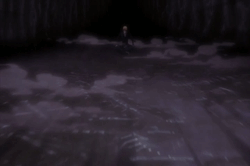 My name is Goggle Bob, and I have a problem. I am addicted to mad-libs character creation.
My name is Goggle Bob, and I have a problem. I am addicted to mad-libs character creation.
I’m sure there’s a better name for this phenomenon, but it’s probably lurking around TVTropes, and I haven’t gone back there since… the incident. Assuming no one has already done so, I’m coining mad-libs character creation as the term to describe, well, 90% of shonen fighting anime, roughly 60% of JRPG supporting casts, and practically every Power Ranger ever. Speaking of Power Rangers, that’s probably what I would use as the most obvious example of this concept. For instance…
The Red Ranger is strong, possess great leadership capabilities, wields a sword, and drives a T-Rex.
The Blue Ranger is smart, makes all kinds of gadgets, wields a tri-fork, and drives a Triceratops.
The Black Ranger is funky, can breakdance, wields an axe, and drives a Mastodon.
Et cetera forever. Yes, these characters are more than their component pieces (Billy has glasses!), but their cores can still be summarized with brief sentences containing a few variables. This isn’t a bad thing! In fact, particularly for children’s shows, this is a good thing, as it allows the characters to be almost instantly established so we can get to the real meat of the story, which usually involves fighting some pig-head creature. Really, you can squeeze a lot out of these “simple” dynamics (for instance, what happens when The Funky One tries to teach The Smart One how to dance? Hilarity!), and, while you’re not producing Sense and Sensibility, who cares? It’s a fun time for all, and it conserves time for the giant robot fighting time we all know and love.
JRPGs (and games with JRPG plots) are the biggest culprits in the video game world for the propagation of this trope. Where once a cave or fortress would be cleared by simply battling the dragon or a giant skeleton, 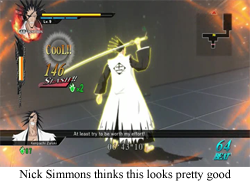 now every boss battle must be significant, which necessitates creating “memorable” bosses, which naturally leads to fashioning a posse for your big bad, which tends to include “noble strong man with axe”, “sadistic brainy guy with unusual weapon”, and “woman (that’s a personality trait, right?) with daggers”. Sprinkle in a few memorable outfits and/or hairstyles, and you’ve got a full villainous supporting cast. If you need a quick, modern example, look no further than Kingdom Hearts’ Organization 13, which, after firing those guys, decided to make a whole new Organization with the same effortless stereotypes but they’re all the same guy.
now every boss battle must be significant, which necessitates creating “memorable” bosses, which naturally leads to fashioning a posse for your big bad, which tends to include “noble strong man with axe”, “sadistic brainy guy with unusual weapon”, and “woman (that’s a personality trait, right?) with daggers”. Sprinkle in a few memorable outfits and/or hairstyles, and you’ve got a full villainous supporting cast. If you need a quick, modern example, look no further than Kingdom Hearts’ Organization 13, which, after firing those guys, decided to make a whole new Organization with the same effortless stereotypes but they’re all the same guy.
But the biggest offender of them all, no matter the genre or origin, is the anime/manga Bleach. Bleach, practically from the first moment, abuses basic archetypes to fill out its main cast (noble hero, serious supporting lady, “silly” supporting woman, strong guy, smart guy, whacky dad, mysterious shopkeep, ninja cat [redundant]), and then, after establishing the rules in a mundane “slice of life” environment, takes its “afterlife investigations” premise to Heaven, Hell, and everywhere in between. Along the way, protagonist Ichigo winds up having to fight every creature that so much as sneezes in his direction, and the “supporting” cast is filled out with… let’s see here… 12 Captains, 12 Lieutenants, 8 Visored, 10 Espada, another 10 lesser Arrancars, and a host of whacky Hollows that all have a thirst for human souls. And that’s before we get into the anime filler episodes! If you used a single chapter/episode to introduce each gang mentioned, you’d have a 52 episode season without even trying. Maybe you could use the second season to explain their collective backstory? 500 episodes later, you might get to the “important” plot.
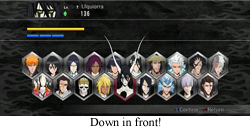 While it’s not quite that bad, Bleach revels in its overflowing cast. One murder mystery takes approximately fifty episodes because practically everyone involved has to be tapped for reactions, and catching the culprit of that caper takes another seven seasons because he instantly amasses an army of outlandish allies. Every hero, villain, and everything in-between has to have a clear motivation, backstory, special skill, and (usually) transformation, so what equates to a milk run in Ichigo’s world takes approximately decades of real-world time.
While it’s not quite that bad, Bleach revels in its overflowing cast. One murder mystery takes approximately fifty episodes because practically everyone involved has to be tapped for reactions, and catching the culprit of that caper takes another seven seasons because he instantly amasses an army of outlandish allies. Every hero, villain, and everything in-between has to have a clear motivation, backstory, special skill, and (usually) transformation, so what equates to a milk run in Ichigo’s world takes approximately decades of real-world time.
And I eat that slop up with a spoon.
It’s all because of the mad-libs character creation, too. See, the MLCC system has a major advantage over the more traditional “this is just the smart guy” style of filling the cast: it creates a pattern. In the world of Bleach, for instance, every character has a transformation of some kind. For the Soul Reapers, it’s Bankai, which allows the person to “release” their sword/soul, and gain an incredible powerup, usually something to do with their weapon of choice transforming or melding with the character. With the Arrancar, it’s Resurrección, which generally transforms the villain into a “monster form” that’s good for a few rounds. And somewhere in-between, there’s the Visors who can transform into a sort of Hollow-lite form that… oh, you get the idea. Point is, every character, and I do mean every character, has a unique weapon, weapon magic skills, and transformation that you better believe is going to be showcased before they’re inevitably defeated. Couple this with the fact that the featured good guys and bad guys will, in typical DBZ fashion, transform about sixty times before the grand finale, and you’ve always got a reason to tune in. Sure, the plot is 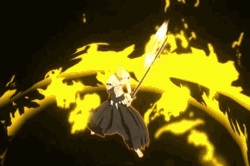 moving about as fast as molasses stuck to a mollusk, but OMG you guys,
moving about as fast as molasses stuck to a mollusk, but OMG you guys, Cell Aizen is going to achieve his perfect final form this week!
Bleach: Soul Resurrección is a beat ‘em up in the Dynasty Warriors vein, where you’re (generally) a hero attempting to knock over about a thousand mooks per level on your way to battle a boss that, for some reason, doesn’t fall over dead after five sword slashes. The challenge isn’t in the swarms of nameless creatures that are eliminated by generating a strong breeze, the “challenge” is acquiring as many points as possible for the absolutely deranged goal of seeing how many beings you can speedily kill. Wow, you slaughtered 300 sentient beings in three minutes! You’re a monster winner! Bah, Mario does not weep for goombas, and Ichigo pays no mind to defeated hollows, business as usual.
But what keeps me playing this murder simulator is not the action or the bloodlust, it’s that it abuses the exact same appeal as its parent anime. Like many games in this vein, as you progress through the story mode, you unlock more and more characters to utilize. Whether you unlock the character because you play through the story as that character, or if said character was the boss of the level is immaterial, what’s important is that you now have a whole new sword guy to play as in the challenge stages. Yes, 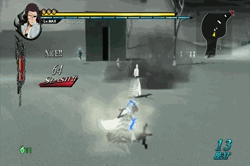 I just unlocked a murderous psychopath that wants to destroy the planet, but, oh boy, he’s got wings! Complete with the final boss unlocking as playable after the final stage, it’s obvious that this game knows where its sword is shined: right there in the character roster. Like the cookie dangling at the edge of the treadmill, you’re going to keep running in place in pursuit of the gooey deliciousness that is a completely unlocked player select screen.
I just unlocked a murderous psychopath that wants to destroy the planet, but, oh boy, he’s got wings! Complete with the final boss unlocking as playable after the final stage, it’s obvious that this game knows where its sword is shined: right there in the character roster. Like the cookie dangling at the edge of the treadmill, you’re going to keep running in place in pursuit of the gooey deliciousness that is a completely unlocked player select screen.
And, like the parent series, there’s so little actual difference between these characters, it’s disgusting. Here’s sword guy. There’s serious sword guy. Oh boy, I just unlocked crazy sword guy while I was trying to unlock ice sword guy. There’s barely any shift in gameplay between these characters. There’s one guy with guns, and aside from that, every character in this game is just using melee weapons of varying length, and were you to tell me they all had the exact same “basic” moves, I would believe you. I’d take the time to discover the inevitable, subtle differences, but every stage is just “hammer square forever” anyway. And it’s abundantly obvious that the designers completely shied away from including the more interesting possible combatants, like Orihime, bulbous blind locust man, and that dinosaur dude, because they might require more than five minutes of effort for new attack animations.
But what cast there is all have different special moves and different bankai transformations, so I keep coming back for more. Ichigo, of course, plays almost exactly the same as “Final” Ichigo or “Entirely Clad in Skulls For Some Reason” Ichigo, but I’ll be damned if those ridiculous palette swaps stay locked away. What is even the point in being alive if there’s a Grim Reaper on the roster and I can’t play as him? I need to unlock King Skeleton right the hell now! No, I don’t care about the game being repetitive drivel based on a license that is, at its core, already repetitive drivel, I need to see that one dude hold a sword with two hands instead of one because that’s really important for some reason! Just hook it to my veins!
My name is Goggle Bob, and I have a problem with mad-libs character creation. I am not currently seeking treatment.
FGC #98 Bleach: Soul Resurrección
- System: Playstation 3. That’s it? Seems like it’s been a while since that happened.
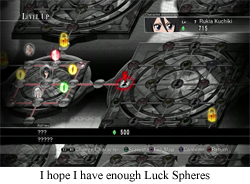 Number of Players: Just one. You’d think a game like this would be ideal for cooperative play, but I guess no one wanted to figure out how to code those split screens.
Number of Players: Just one. You’d think a game like this would be ideal for cooperative play, but I guess no one wanted to figure out how to code those split screens.- Level Up: I normally despise leveling in a game like this, as, while it’s always fun to gain more strength, defense, and HP as you go, in a setup like this, the odds are good that your main fighter will be Level 70 by the time you unlock the last character that is just starting at Level 1. Go ahead and try to train him up to conquer the same stages, I’ll wait (no I won’t). That said, Bleach: Soul Resurrección does frame its leveling system in a practically copyright challenging Sphere Grid, so at least it’s fun to move around the “board”. I don’t completely hate it.
- Favorite Character (in game): Coyote Starrk aka The One with the Guns. He might be the only real change in gameplay on the roster (maybe Byakuya Kuchiki offers a little difference with his dancing flower petal attacks… did I just type that?), and his long range attacks with sweet gun-fu movements make him my de facto choice. Also, I guess he can summon wolves? Or are they supposed to be coyotes? That would make sense…
- I don’t wanna die: So, apparently, the afterlife of the Bleach universe either involves going to “Hell” and becoming a soul devouring monster, going to “Heaven” and joining the high ranks of Soul Society to fight previously mentioned monsters for hundreds of years, or going to that same “Heaven” and lingering around for centuries in a rigid caste system modeled after feudal Japan. Camus couldn’t imagine something so absurd.
- Unfortunate Implications: All the “good” Soul Society characters use techniques that are in Japanese. All the “gray-area” Quincy (all two of them) use techniques that are in German. All the evil, soul-devouring Hollow/Arrancar use techniques that are in Spanish. I’m sure Donald Trump would approve.
- Did you know? Tite Kubo, author/creator of the Bleach manga, has admitted that he just likes creating new and interesting characters, and isn’t too worried about the overarching plot of the series. No $^&%ing duh, man.
- Would I play again: Unfortunately, yes. Sometimes you just want to recklessly slaughter the legions of Hell, you know?
What’s next? Random ROB has chosen… Captain Planet and the Planeteers for the NES! Well, I suppose saving the planet is the thing to do, so let’s give it a shot. Please look forward to it!
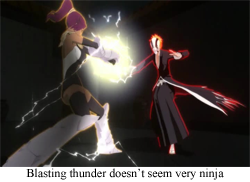

While I’m not about to try penetrating a series* that’s spanned hundreds of episodes and dozens of manga chapters, I can definitely relate to the excitement of unlocking new characters in the games, especially when it’s a series I like. I might not think much of Fi and Zant in their respective games but they made for awesome fighters in Hyrule Warriors.
If there was a Musou game based on Star Wars or Final Fantasy VII, I could say goodbye to all of my time for playing games that weren’t those things right then and there. Still wanna get Dragon Quest Heroes eventually, at least if PSN sales and good cheap games stop tempting me for a few weeks.
* Has anyone ever explained why that anime was named after liquid chlorine?
I’ve never seen an explanation myself, though I have developed an interpretation over the course of the show.
I think of it as a metaphorical reference to how Ichigo never fits in to any of his peer groups. At school he’s the guy with orange hair who “is obviously a deviant, look at that bright orange hair! He either does bleach and dyes it to stand out or should to fit in.” At home his Dad is whacky and sister is filling in for Mom. He becomes a Shinigami and Soul Society is all “nope, no mortal Gaijin allowed, please die now.” He saves Soul Society a bunch of times and lots of people like him, but he’s still breaking the rules just by existing. Repeat ad infinitum.
So Bleach refers to his different coloured hair and the way he (doesn’t) fit in to regular society.
But if we’re being realistic here it’s probably because using English words is cool and white is associated with death in Japan. See also: why Neon Genesis Evangelion has all that religious imagery.
Goggle Bob likes this post.
[…] average people are menaced by malevolent Creatures of Grimm, (which look like a mix between the Hollows of Bleach and the Heartless of Kingdom Hearts). But have no fear! As brave warriors known as […]
[…] attacks, and his weapon is a railgun), but I fall for it every time. See also: Kingdom Hearts, Bleach, and the War of the Light from Green Lantern […]
[…] of a lot of conflict during Chronophantsma, but he’s ultimately subdued and made irrelevant when Ichigo finally shows Kenpachi who’s […]
[…] And I have been thinking about this phenomenon a lot recently, as I have been gradually rewatching Bleach. […]